Abstract
Changes in nutrient concentrations in groundwater were investigated to determine the impact of agriculture on water quality in artificial lakes. The study covered three reservoirs in an agricultural area of Wielkopolska (central-western part of Poland). Assessing the agricultural impact required a network of piezometers around the reservoirs, used to determine the degree of groundwater pollution from nutrients supplied to the reservoirs. Moreover, the analysis covered the quality of water in streams flowing into the reservoirs, and in the reservoirs themselves. Field research was conducted every month of the growing season from March to November. The analysis covered land inclination, ground permeability, and soil type. Detailed objectives included: (1) assessment of the agricultural impact on the chemical parameters of ground and surface water quality, and (2) evaluation of the impact of different sources of agricultural pollution on water quality in artificial reservoirs in regards to their management. This study revealed high dynamics of nutrient concentrations, particularly for nitrates and phosphates, in groundwater and surface water. A significant effect of maize cultivation on an increase in nitrate concentrations in the groundwater of the catchment of the Przebędowo Reservoir was evidenced, as well as a substantial effect of the functioning of an animal farm on the quality of groundwaters in the catchment of the Lachotka Reservoir. The nutrient load of agricultural origin in the catchment of the Miedzichowo Reservoir was relatively low. Our study revealed elevated amounts of nutrients such as nitrogen and phosphorus, detected more frequently in groundwater than in running waters, which confirms our hypothesis of the importance of groundwater analysis in detecting the source of pollution of the studied lakes. High nutrient concentrations recorded in groundwater leached from arable fields were also observed in the summer period, failing to confirm the hypothesis that the greatest effect of factors would be related to the spring effect of arable fields on water quality (lack of compact vegetation cover, high water level, etc.). Our study also indicated a greater importance of the type of land use than lithology or permeability of deposits.
1. Introduction
Higher than average nutrient concentrations of anthropogenic origin occurring both in surface and ground waters is a significant threat to the natural environment. Water degradation of aquatic ecosystems caused by agricultural activities is a global problem [1,2,3,4]. In the European Union, nitrogen (N) has been recognised as one of the major factors for water pollution and an indicator of the impact of agriculture on water quality [5]. However, the determination of the agricultural impact on water quality is quite difficult due to the spatial character of pollution [4,6].
Studies on water pollution in lake ecosystems are frequently limited to investigating the source of surface water pollution or sediment resuspension [7,8]. Although agriculture is considered to have one of the greatest impacts on surface water quality, it is still omitted in standard monitoring [9] and lake monitoring [10]. Furthermore, measures undertaken for the purpose of lake reclamation focus on the reduction of phosphorus concentrations in water and sediments [11]. Nitrate concentrations, recognised as a major form of nitrogen from agriculture, are only partially taken into consideration, although knowledge on the impact of N on lake eutrophication [11,12,13,14] and human health is well established [15,16]. High availability of N in water increases growth of phytoplankton [17,18]. Moreover, cyanobacteria can uptake N from the atmosphere, and increase algal blooming in lakes [19]. Considering this phenomenon, reduction of N pollution seems to be less effective than of phosphorus (P)pollution. In some lakes, however, N pollution can play a major role in lake eutrophication. Neglecting it can cause further lake degradation despite the applied reclamation measures.
Identification of sources of pollution is crucial for effective lake protection, and for proper planning of their recultivation. Establishing a monitoring network of wells in agricultural catchments offers such a possibility. According to Pinardi et al. [20], N concentrations were recorded only in spring, suggesting that determining the agricultural impact is only possible when considering early water quality measurements. Otherwise, the determination of agricultural water pollution may be incomplete or subject to significant error. For example, Torres-Martínez et al. [21] and Cameira [6] showed elevated N levels detected in the groundwater throughout the year, although this was reported in an area under pressure from animal husbandry. The purpose of our research was also to stress the problem of seasonal occurrence of pollution from agricultural activity. Many studies focus on the agricultural impact of N leaching from fields, or on the effect of animal production on the environment, and limiting this effect from N forms, namely nitrate or ammonium [22,23,24]. Phosphorus, as one of the major pollutants of water bodies from agricultural areas, is mostly neglected due to its low mobility in groundwater, and higher absorption through the soil complex [25]. Phosphorus pollution, however, can also be problematic due to high fertilisation rates, e.g., of manure [26]. This issue requires more thorough investigation.
The agricultural impact on water bodies can be even stronger due to climate change. Nutrient leaching, particularly in the case of mobile nitrates, increases during or after intensive precipitation or slow melt [1,2]. It results in elevated concentrations of nitrogen in the surface and ground waters. The thickness of snow cover, its duration, and temperature also substantially affect the biogeochemical processes in the soil that influence the migration and/or accumulation of nitrogen in the soil [27,28]. These factors will affect to various degrees the uptake and availability of nutrients for crops, as well as the rate of their loss from the habitat. Determining their circulation route is of key importance for properly conducting agricultural activity with a minimum effect on the environment. These changes in meteorological conditions cause issues with water availability, particularly in agricultural areas. One example is the Wielkopolska region (central-western part of Poland) which has been strongly affected by drought over recent decades [21,22]. One of the solutions to increase water retention in the region was the creation of artificial reservoirs [29]. However, in most cases, artificial lakes are located in agricultural areas, dominated by arable fields or used for intensive animal production [30]. Determining the agricultural impact on water quality (surface and groundwater) therefore appears crucial for maintaining reservoirs in good state. These kinds of aquatic ecosystems are young in the geological scale, and the ecological and morphological processes observed in such ecosystems show high dynamics [31]. The undertaken activities therefore require careful planning with consideration of the potential impact of non-point sources.
The objective of the study was to (1) assess the impact of agriculture on chemical properties of ground- and surface water quality, particularly nitrogen and phosphorus, (2) evaluate the effect of land slope, surface lithology, permeability of deposits, and land use on groundwater quality in terms of surface water pollution, and (3) evaluate the impact of different sources of agricultural pollution on water quality in artificial reservoirs in regards to their management.
2. Materials and Methods
The study was carried out in three catchments of artificial lakes in the central-western part of Poland (Figure 1A–C).
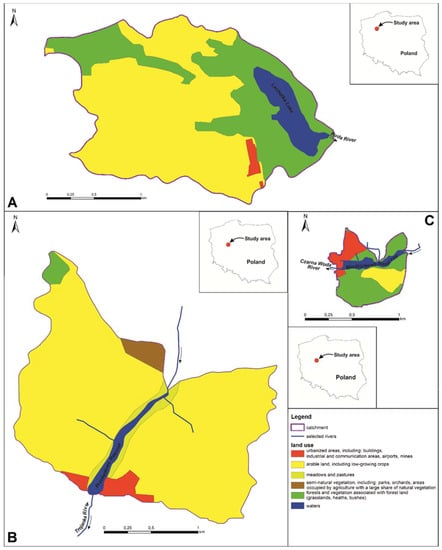
Figure 1.
Location of the analysed reservoirs (A) Lachotka, (B) Przebędowo, (C) Miedzichowo with their land use structure in the direct catchment.
The analyses included phosphate dynamics, total phosphorus, nitrogen, ammonium, and total nitrogen concentrations in surface (reservoir and tributaries) and groundwaters (in wells in the vicinity of the lakes). Moreover, land use in the catchments, land slope, lithology, and filtration were considered in the analysis of the potential impact of land use on water quality in the studied water bodies. Data on meteorological parameters, such as temperature and precipitation, were obtained from the Institute of Meteorology and Water Management—National Research Institute, from meteorological and precipitation stations located nearest to the analysed catchments. Climatic analyses considered mean monthly temperatures calculated based on daily data, and monthly precipitation totals from daily data.
2.1. Surface Waters
Water quality in the reservoirs was analysed in the deepest part of each reservoir monthly from March to November 2016 and 2017 (R1, R2; Figure 2a–c). In running waters, samples were collected from the surface in the central part of the current section. The inflow and outflow of the Trojanka River (T1) to the Przebędowo Reservoir (PR), that of the Czarna Woda River (T1) to the Miedzichowo Reservoir (MR), and the outflow of Ruda River (T1) from Lake Lachotka (LR) were measured. Moreover, samples from the running tributaries of the studied reservoirs were analysed: two periodic tributaries and an additional outflow from Lake Miedzichowo, two streams and periodic drainage outflows supplying water to the Przebędowo Reservoir (T2, T3), and three tributaries to Lake Lachotka (Figure 2a–c). Water flow velocity was measured using a Universal Wing F1 hydrometric mill.
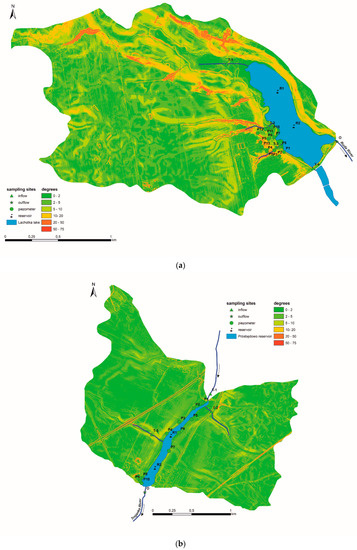
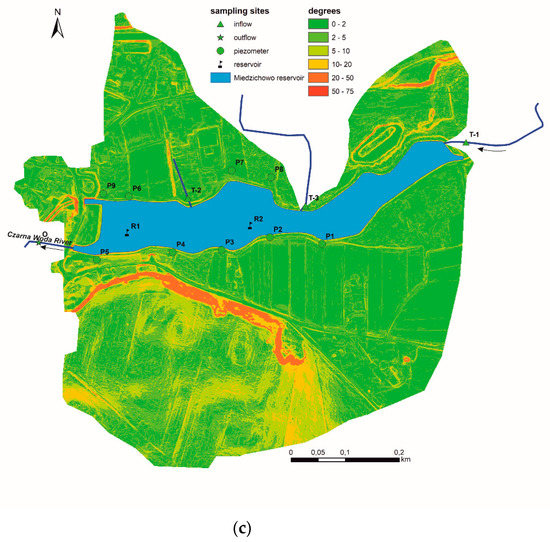
Figure 2.
Study sites for surface and groundwaters in the catchments of the (a) Lachotka, (b) Przebędowo, and (c) Miedzichowo Reservoirs on the background of catchment slopes.
Water samples were collected in two plastic bottles. For total forms of nutrients, water was not filtrated. For other analyses, water was filtered using Sartorius filters with 0.45 µm pore size. In situ measurements of pH, temperature, conductivity, and soluble oxygen concentrations employed digital potentiometers Elmetron CP-401, CC-551, and ProfiLine Oxi 3315. In open water, transparency was detected by Secchi disc depth [32]. Chlorophyll a concentration was measured spectrophotometrically in accordance with methods described by Siepak et al. [33], using a HACH DR/2800 spectrophotometer. All chemical analyses were carried out at the Department of Ecology and Environmental Protection, Poznań University of Life Sciences, within 6 h from collection. Chemical parameters were measured using standard methods [34]: phosphate (amino acid method), total phosphorus (acid persulphate digestion method), nitrate (cadmium reduction method), nitrite (ferrous sulphate method), ammonium (Nessler’s method), organic nitrogen (Kjeldahl’s method), sulphates (colorimetric method), and chemical oxygen demand (COD; dichromate method); all were performed by means of a HACH DR/2800 spectrophotometer [34]. Biological Oxygen Demand (BOD5) was determined based on the Winkler method. Water quality in the reservoirs was evaluated in accordance with Carlson’s trophic state index [35] and methods by Forsberg and Ryding [36]. Carlson’s trophic state index was calculated as a mean value of total phosphorus, chlorophyll a, nitrogen, and Secchi disk depth (summer measurements):
where each indicator was calculated according to the following formulas:
where: TSI—Carlson’s trophic state index, TP—total phosphorus (µg/L), Chl—chlorophyll a (µg/L), SD—Secchi disk depth (m), TN—total nitrogen (mg/L), and n—number of analysed parameters.
TSI = [TSI(Chl) + TSI(SD) + TSI(TP) + TSI(TN)]/n
TSI(Chl) = 9.81 ln(Chl) + 30.6
TSI(SD) = 60 − 14.43 ln(SD)
TSI(TP) = 14.43 ln(TP) + 4.15
TSI(TN) = 54.45 + 14.43 ln(TN)
Based on the TSI values, the lakes were classified as oligotrophic (low productivity; TSI < 40), mesotrophic (moderate productivity; TSI = 40–50), eutrophic (high productivity; TSI = 50–70), and hypereutrophic (very high productivity; TSI > 70).
2.2. Groundwater
Evaluation of the influx of pollutants into the three reservoirs involved the analysis of groundwater from the water-carrying horizon I. The depth of wells varied from 1.5 m to 3.5 m. Piezometers were installed in the shore zone of the reservoirs neighbouring urbanised areas and arable land. Ten wells were bored in the catchment of Przebędowo, eight in the Miedzichowo catchment, and 13 in the Lachotka catchment (Figure 2a–c). Water samples from piezometers and surface waters were collected on the same day. Physical parameters of the groundwaters were measured using similar standard methods as indicated for surface waters. Nitrate (cadmium reduction method), nitrite (ferrous sulphate method), ammonium (Nessler’s method), organic nitrogen (Kjeldahl’s method), total nitrogen (sum of the analysed forms of nitrogen), phosphate (amino acid method), and total phosphorus (acid persulphate digestion method) were determined using a HACH DR/2800 spectrophotometer [34]. Groundwater quality was evaluated according to Polish Regulations [37] base on the Nitrate Directive [5].
2.3. Catchments
The catchment areas of the studied reservoirs were delimited based on current topographic maps and the Map of the Hydrographic Division of Poland at a scale of 1:10,000 [38]. Land use in the analysed catchments was evaluated based on materials of the Chief Inspectorate of Environmental Protection and Corine Land Cover at a scale of 1:10,000 (CLC) resource [39]. In the case of the Przebędowo and Miedzichowo Reservoirs, the data were updated by the reservoir flooding area using digitisation of objects visible in orthophotomaps included in the resources of the Central Geodetic and Cartographic Resource, prepared under the ISOK (IT System of Protection of the Country) and LPIS projects (Identification System for Agricultural Plots) at a scale of 1:500, 1:1000, or 1:2000 depending on data availability. Moreover, urbanised areas in the western part of the Lachotka catchment that were not included in the previously mentioned databases were vectorised. Considering the level of detail of the CLC maps in terms of third level classes, the division was generalised to six main aggregated areas, namely: urbanised areas, arable land, meadows and pastures, semi-natural vegetation, forests and vegetation related to forest land, and water.
The slope maps were made based on data available on the website of the Main Office of Geodesy and Cartography [40], obtained from *asc files, through generating a numerical terrain model. For the surveyed catchments, a total of eight data sheets were collected in the PL-1992 (PL-KRON86-NH) layout with a horizontal grid of 1.0 m and vertical accuracy of 0.15 m according to the current state as of 2012 (six sheets) and 2016 (two sheets). After developing a raster map of the numerical terrain model in the ArcGIS software, the built-in spatial analysis tool ArcGIS—Slope was used to generate maps of land slopes (planar method, Zfactor = 1) assuming the class intervals proposed by the algorithm.
The lithology maps of the area were drawn based on the vectorisation of the sheets of the Detailed Geological Map of Poland at a scale of 1: 50,000. Considering the degree of detail and multitude of separations, the data were generalised in terms of similar lithological features, therefore enabling a uniform cartographic presentation of the analysed catchments. The resulting division was aggregated by filtration characteristics through the designation of seven classes of soil permeability, from class 1—soils with the weakest permeability (e.g., tilts) to class 7—soils with the highest permeability (e.g., sands and glacial gravel). For the determined classes, potential filtration coefficients k were indicated based on Kozerski and Pazdro [41] and Wąsik [42]. The ArcGIS software program (Esri, Poland) was used for geographic analysis and cartographic representations.
2.4. Statistical Analyses
Principal component analysis (PCA) was applied to investigate the differences between the analysed groundwater collected from different piezometers in terms of water chemistry. The statistical analyses were performed using the Statistica (StatSoft, Kraków, Poland; version 13.2 software.
Canonical correspondence analysis was used for analysis of the correlation between surface lithology, permeability of deposits, slope, land use in the catchment, and groundwater quality parameters using CANOCO for Windows version 4.5 [43]. Redundancy analysis (RDA) with forward selection was used to reduce the number of environmental variables. The statistical significance of the correlation between the analysed variables was evaluated using the Monte Carlo permutation test (499 perturbations). All data were log-transformed before analysis [43].
3. Study Sites
3.1. Lachotka Reservoir
Lake Lachotka is located on the Ruda River near the city of Piła, in north-west Poland (Figure 1A, Table 1). This artificial lake was created through damming the waters of the Czaplica River, resulting in connecting two reservoirs. Its maximum height is 3.5 m, averaging 1.4 m (Table 1). The surface area is 39.62 ha at a damming elevation of 76.3 m above sea level (Fishing Unit in Wałcz). Annual water level fluctuations are in the range of 0.5–0.60 m. The greatest depth at the average damming level reaches 4 m.

Table 1.
Morphometric parameters of the studied reservoirs: Lachotka, Przebędowo, and Miedzichowo.
Lake Lachotka is fed by four tributaries, including two periodical ones, feeding the lake from north and south-west. On the latter two’s course, supplying the lake from the west, reservoirs were built as part of a small retention program in forests. The northern tributary begins in the village of Zawada, flowing through the village of Stara Łubianka and farmlands.
The lake has one outflow, namely the Ruda River. A damming outflow box was installed at its outlet from the lake, with a height of 3 m and a discharge pipe with a diameter of 800 mm, permitting complete drainage of water from the lake within two months. Water from the reservoir is currently supplied by the Ruda River to fish ponds in the Czaplica colony. These ponds (including earthen ponds and fish hatcheries) are used for fish farming and breeding where, in addition to traditional carp production, fish species valuable from an environmental and economic point of view are bred, including whitefish, vendace, and pike. Fisheries management is conducted on the lake (commercial and angling).
3.2. Przebędowo Reservoir
The Przebędowo Reservoir is located in the Przebędowo village, around 25 km from the Poznań agglomeration in central-west Poland (Figure 1B, Table 1). The reservoir was created in 2014 by damming the Trojanka River between 6915 km and 8371 km of its course. Its surface is 15.04 ha, and capacity 229,450 m3. Its maximum water depth is recorded near the dam, reaching 1.4 m, and averaging 0.94 m at a water level of 72.50 m a.s.l. (Table 1).
The reasons for creating the Przebędowo Reservoir were as follows: water storage for agriculture, flood control, fire protection, and recreational use such as swimming and fishing. Due to poor water quality, however, the lake’s recreational use is prohibited.
The Trojanka River is the major source of water with an inflow in the north-eastern part of the reservoir. Two other tributaries feed the reservoir from east and west.
3.3. Miedzichowo Reservoir
Lake Miedzichowo was created on 6000 km of the course of the Czarna Woda River in the Miedzichowo village, 80 km west of Poznań in west Poland (Figure 1C, Table 1). A small stream supplies water to the reservoir in the western part of the catchment. In 2013, the reservoir was reconstructed and enlarged. Its surface area was increased from 2.5 ha to 5.5 ha, and capacity from 16,000 to 70,500 m3. The actual surface area of the reservoir is 5.5 ha, and its average depth reaches 1.4 m. The reservoir was created at the beginning of the 20th century for the purposes of a local water mill. Over the last two decades, a small hydroelectric power station has been functioning at the outflow of the reservoir. The reservoir also serves the function of flood control and fire protection, as well as recreation, particularly fishing.
4. Results
4.1. Catchments
4.1.1. Lachotka Reservoir
The catchment area of Lake Lachotka covers 3.87 km2 and 61% is occupied by arable fields (Figure 1A, Table 2). The lake is surrounded by forests, creating a zone with a width of 250–450 m. The largest complex of arable fields is located in the western part of the watershed. A large pig farm functions next to the lake. Liquid manure is stored in open containers near the piggery. As a result of concrete corrosion, leaching of pollutants into the ground have been observed. Cereals and rape are the dominant crop production in the catchment. Mineral fertilisation of the fields is low, at a level of 139 kg NPK/ha per year (84 kg N/ha, 26 kg P/ha and 28 kg K/ha) (Municipal office in Szydłowo, unpublished data). Moreover, the fields are intensively treated with organic fertilisers, namely manure and slurry.

Table 2.
Land use in the catchments of Lachotka, Przebędowo, and Miedzichowo Reservoirs.
The surface lithology of the catchment of the Lachotka Reservoir is largely varied. The southern part of the catchment is dominated by glacial tills of the North Polish Glaciation, and in the central, western, and northern part by sands, gravels, and glacial boulders deposited on the aforementioned glacial tills (Figure 2a, Table S1). The eastern part of the catchment and its immediate vicinity is built of sands and fluvial-glacial gravels as well as sandy silts related to the former Ruda River valley. The ground lithology largely determines the land use structure, dominated by arable land with better soils occurring on loamy complexes (Figure 1A), and forests related to sandy formations (Table 2).
In 2016 and 2017, temperature varied from −16.0 °C in January to 33.6 °C in June. Monthly temperature was much lower, ranging between −2.3 °C in January to 18.6 °C in July. The precipitation total reached 425 mm in 2016, and 689 mm in 2017 (Table 3).

Table 3.
Monthly precipitation and temperature in the catchments of the analysed reservoirs.
4.1.2. Przebędowo Reservoir
The catchment of Lake Przebędowo covers an area of 93.7 km2. Most of the area is covered by forest and arable fields, respectively occupying 51% and 43% of the catchment (Table 2). Forests mostly cover the south-eastern and northern parts of the catchment. The direct watershed supplying the reservoir from surface runoff is 91% covered with arable fields. High land slopes towards the reservoir are unfavourable (Figure 2b). Crops are dominated by maize, sown almost every year. The urban area covers 2.1 km2, i.e., 2% of the catchment. The Przebędowo village is located near the reservoir (Figure 1B). In the direct catchment, where water is directly supplied to the reservoir, the largest area is covered by arable fields (88%).
The surface geological structure of the direct catchment of the Przebędowo Reservoir is largely dominated by glacial tills of the North Polish Glaciation, and thin layers of fluvioglacial sands and weathered sands deposited on glacial tills (Table S1). Peats and aggradate muds are primarily deposited in the Trojanka valley, and in its higher parts, sands and fluvioglacial gravels as well as humic sands, also observed in the valley of the periodical stream flowing into the reservoir to the west. The land use structure is dominated by arable land on good soils related to loamy complexes. Wetland parts of the Trojanka valley are occupied by meadows and pastures. The southern part of the reservoir’s catchment covers the building development of the town of Murowana Goślina (Figure 1B).
Precipitation in the catchment of the Przebędowo Reservoir in 2017 was the highest among the studied catchments, reaching 1035 mm (Table 3). It is worth emphasising that it was the highest precipitation value in the history of measurements conducted in that area, dating back to the 1940s. Average precipitation from the multiannual period for the area is 550 mm annually. The highest monthly precipitation total was recorded in July—157 mm and 217 mm in 2016 and 2017, respectively. Monthly temperature varied from −2.2 °C in January to 19.3 °C in July 2017.
4.1.3. Miedzichowo Reservoir
In the Lake Miedzichowo catchment, with an area of 271.8 km2, the largest area is covered by forests—49% and arable fields—45% (Figure 1C, Table 2). Buildings and other urban areas occupy approximately 2% of the catchment, and are mostly located in its upper, northern part. The Miedzichowo village is located near the reservoir. Arable land mostly occupies the north-west of the lake catchment. The direct catchment is dominated by forests (55%). Arable fields and building development cover 34% of the direct catchment (Table 2).
The highest percent share of the direct catchment of the Miedzichowo Reservoir is occupied by fluvioglacial sands, observed in the north and central part of the area (Table S1). The area in the southern part of the catchment is entirely built of sands and gravels of terminal moraines. Along the axis of the Czarna Woda River valley, sandy aggradate muds of valley bottoms occur. Very weak soil quality developed on the sandy substrate which translates into a land use structure dominated by forests. Arable land occurs in the form of an isolated patch in the central-east part. North-western and western parts of the reservoir catchment are occupied by the building development of the Miedzichowo municipality.
The studied years were wet and characterised by high precipitation totals, reaching 682 mm in 2016 and 881 mm in 2017. The lowest temperature was recorded in January (−14.4 °C, average −1.6 °C in 2016; −13.6 °C, average −2.2 °C in 2017). The highest temperature was detected in June 2016 (33.9 °C), and in August 2017 (33.6 °C). The warmest month in 2016 was July (Table 3).
The catchment areas of the analysed reservoirs show low land slopes (Figure 2a–c, Table 4). In the Przebędowo catchment, 73% of the area is covered by land with slopes not exceeding 2%. In the Miedzichowo catchment, they reach 61%, and Lachotka 43%.

Table 4.
Variability of land slopes in the catchments of the analysed reservoirs.
The highest land slope was recorded in the catchment of Lake Lachotka, in its eastern part, where it varied from 5 to 25%, and in the catchment of Lake Miedzichowo, covering 3% of the catchment area. The greatest height differences concerned fields adjacent to Lake Lachotka to the east (Table 4).
4.2. Water Quality in the Reservoirs
Water quality in the studied lakes represents an intensive stage of eutrophication (Table 4). Lake Lachotka in particular shows hypertrophic water quality due to high contents of ammonium and phosphorus, and intensive algae blooms reflected as high chlorophyll a concentrations (Table 5). Two Carlson’s indices—TSI (Chl) and TSI (TP)—indicated an advanced stage of eutrophication. Lakes Przebędowo and Miedzichowo are also characterised by high phosphorus concentrations, expressed as the Carlson index (TSI (TP)), suggesting hypertrophic water quality. The other two indices point to the eutrophic stage. Considering other parameters, water quality in the studied reservoirs is poor (Table 5).

Table 5.
Characteristics of water quality in the Lachotka, Przebędowo, and Miedzichowo Reservoirs.
4.3. Running Waters
The monthly study of nutrient concentrations in running waters supplying the studied lakes combined with water velocity illustrated the amount of nutrient load supplied to the lakes throughout the year. The Trojanka River (IT-1, Figure 3b) flowing into the Przebędowo Reservoir, and unnamed ditches (permanent T-2, seasonal T-3) supplied 0.5 and 1.35 kg P y−1 and 25.1 and 113.4 kg N y−1, respectively. The Czarna Woda River (T-1, Figure 3c) flowing into the Miedzichowo Reservoir, and short artificial ditches (T-2. T-3) supplied 4.0 and 3.8 kg P y−1 and 67.6 and 43.7 kg N y−1, respectively. The Ruda River (T1, Figure 3a) supplied approximately 6.0 kg P y−1 and 118 kg N y−1 to Lake Lachotka.
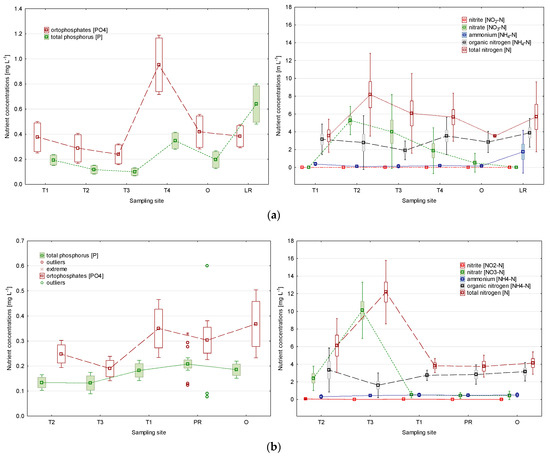
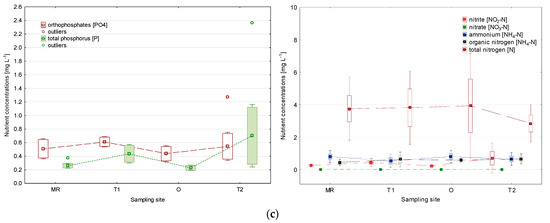
Figure 3.
Boxplots of nutrient concentrations in running waters (Tx—tributary number, O—outflow) in the catchments of the studied reservoirs (a) Lachotka (LR), (b) Przebędowo (PR), (c) Miedzichowo (MR). Boxplots: mean (small square), standard errors (SE, box edges), 2 SE (whiskers), >1.5 standard deviation (outliers) >2.0 standard deviation (outliers).
Regarding the concentrations of nitrogen forms in the running waters, the highest values were detected in small unnamed streams periodically supplying water to the Przebędowo Reservoir. Nitrate concentrations varied from 0.02 mg L−1 to 43.49 mg NO3− L−1. However, pollution with forms of nitrogen in the tributary supplying the Lachotka and Miedzichowo Reservoirs was low and did not exceed 1.3 mg NO3− L−1. Nonetheless, high concentrations of phosphorus were recorded in one of the ditches supplying water to the Miedzichowo Reservoir.
4.4. Groundwater Quality
Analyses of groundwater quality in the three artificial lake catchments indicated high variation of nutrient concentrations (Figure 4, Figure 5 and Figure 6). In the Lake Lachotka catchment, the highest nitrogen concentrations were detected in wells near the farm, reaching 46.78 mg N-NO3− L−1 (207.18 mg NO3− L−1) (Figure 4b). Total phosphorus concentrations varied between 0.06 and 12.01 mg P L−1, and phosphates between 0.07 and 3.93 mg PO43− L−1 (Figure 4a). Extremely high values were detected in one of the wells closer to the lake (P10). Total nitrogen concentrations ranged between 1.50 and 101.00 mg N L−1. Most of the samples with detected high nitrates contained elevated amounts of organic nitrogen (Figure 4b). The highest values of nitrate concentrations were measured in wells near the pig farm.
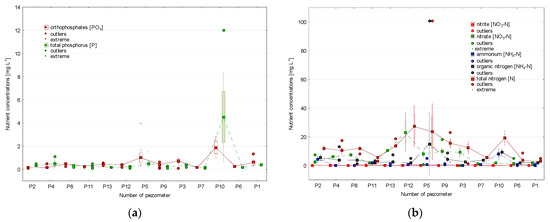
Figure 4.
Boxplots of (a) orthophosphates [mg PO43− L−1], total phosphorus [mg P L−1], and (b) mineral (ammonium, nitrite, nitrate), organic, and total forms of nitrogen [mg N L−1] concentrations in groundwater measured in wells in the Lake Lachotka catchment. Boxplots: mean (small square), standard errors (SE, box edges), 2 SE (whiskers), >1.5 standard deviation (outliers) >2.0 standard deviation (outliers).
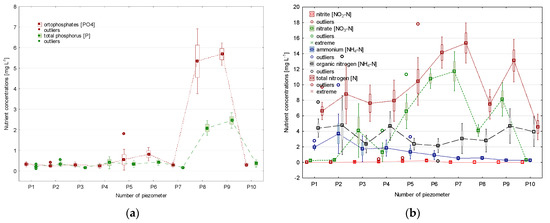
Figure 5.
Boxplots of (a) orthophosphates [mg PO43− L−1] and total phosphorus [mg P L−1], (b) mineral (ammonium, nitrite, nitrate), organic, and total forms of nitrogen concentrations [mg N L−1] in groundwater measured in wells in the Przebędowo Reservoir catchment. Boxplots: mean (small square), standard errors (SE, box edges), 2 SE (whiskers), >1.5 standard deviation (outliers) >2.0 standard deviation (outliers).
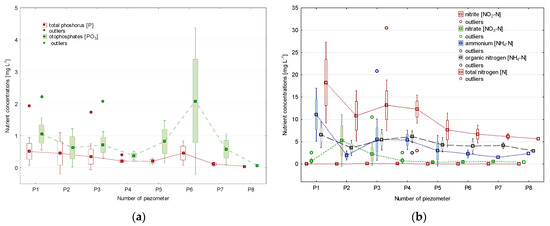
Figure 6.
Boxplots of (a) orthophosphates [mg PO43− L−1] and total phosphorus [mg P L−1], (b) mineral (ammonium, nitrite, nitrate), organic, and total forms of nitrogen concentrations [mg N L−1] in groundwater measured in wells in the Miedzichowo Reservoir catchment. Boxplots: mean (small square), standard errors (SE, box edges), 2 SE (whiskers), >1.5 standard deviation (outliers) >2.0 standard deviation (outliers).
The PCA of the measured chemical groundwater properties showed significant differences between the wells in the Lachotka catchment (Figure 7a), particularly between two groups characterised by different gradients of nitrate concentrations. The first two axes were significant, and together accounted for 80.93% of the variation in the nutrient concentrations in groundwaters. The first principal axis accounted for 53.34% of the variation in groundwater quality, and was negatively correlated with PO43− (r = −0.87), Ptot (r = −0.88), NO2− (r = −0.78), and NH4+ r = −0.84). The second principal axis accounted for an additional 27.59% of the variation in groundwater quality and was positively correlated with NO3− (r = −0.98) and Ntot (r = 0.75).
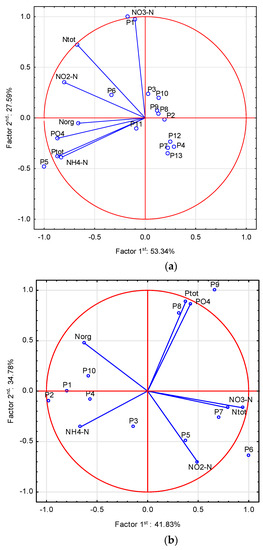
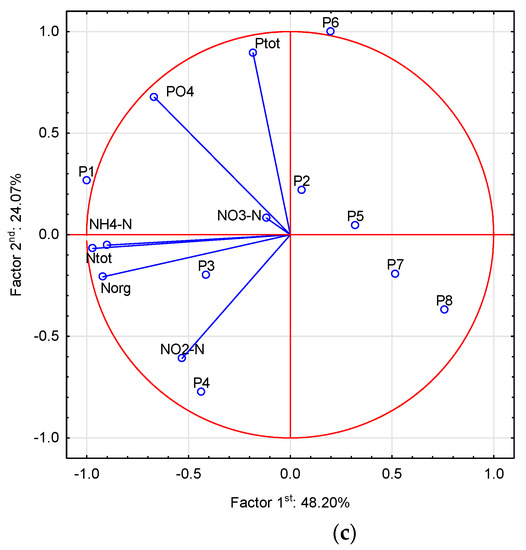
Figure 7.
Principal component analysis of the measured physico-chemical groundwater properties in wells in the (a) Lachotka, (b) Przebędowo, and (c) Miedzichowo Reservoirs. Abbreviations: Ntot—total nitrogen, Norg—organic nitrogen, NO2-N—nitrite, NO3-N—nitrate, N-NH4—ammonium, Ptot—total phosphorus, PO4—orthophosphate; number of wells: P1, P2…
In the Przebędowo reservoir catchment, high phosphorus, total phosphate, and ammonium were detected in two piezometers near buildings (Figure 5a,b). In the part of the catchment intensively used for maize production, with a slope of 2–5 degrees, nitrate concentrations reached 73.51 mg NO3− L−1. The highest values were detected in piezometer P-7 in April, although high values were also recorded in summer (Figure 5a,b and Figure 7b, Table 6). The PCA of the analysed nutrient concentrations in groundwaters showed significant differences between the wells (Figure 7b). The first two axes were significant, and together accounted for 68.90% of the variation in the nutrient concentration in groundwaters. The first principal axis accounted for 41.83% of the variation in groundwater quality and showed a negative correlation of ammonium with NH4+ (r = −0.85), organic nitrogen NH4+ (r = −0.92), and total nitrogen Ntot (r = −0.97). The second principal axis accounted for an additional 24.07% of the variation in the groundwater quality and was positively correlated with phosphates PO43− (r = 0.89). Total phosphorus concentrations varied between 0.05 and 6.8 mg PO43− L−1, and phosphates between 0.11 and 3.00 mg P L−1. The nitrate concentrations ranged from 15 to 35 mg NO3−-N L−1, and ammonium from 0.00 to 9.98 mg NH4+-N L−1.

Table 6.
The monthly mean, minimum and maximum concentrations for 2016 and 2017 of ammonium, nitrite, nitrate, organic, and total nitrogen concentrations in groundwater measured in 10 wells in the catchment of the Przebędowo Reservoir.
The groundwater quality in the Miedzichowo catchment was characterised by the lowest pollution within the studied catchment (Figure 6a,b). Significant differences were detected between piezometers only in respect to concentration of ammonium and nitrates (Table 5). The highest nitrate values (73.51 mg NO3− L−1) were measured in a well located near arable fields (P-6), and ammonium was recorded in wells next to the water treatment plant in the Miedzichowo village (P-1) (Figure 6b).
The PCA of the analysed nutrient concentrations in groundwaters showed an increasing gradient of phosphorus concentration values (0.08–5.93 mg P L−1) (Figure 7c). The first two axes were significant, and together accounted for 68.90% of the variation of nutrient concentrations. The first principal axis accounted for 48.20% of the variation in groundwater quality and showed a negative correlation of ammonium with NH4+ (r = −0.85), organic nitrogen NH4+ (r = −0.92), and total nitrogen TN (r = −0.97). The second principal axis accounted for an additional 34.78% of the variation in groundwater quality and was positively correlated with phosphates PO43− (r = 0.89).
Pursuant to Polish regulations [37], groundwater in the Przebędowo and Lachotka catchments were classified as poor, and in the Miedzichowo catchment as good water quality.
4.5. Impact of Soil Parameters and Land Use on Groundwater Quality
In order to better understand the changes in groundwater quality, the analyses covered soil properties, slope, and land use in regards to forms of N and P content. The RDA analyses showed that the first two axes explained 98.6% of the analysed soil and land use variances (Table 7; Figure 8). The correlation between the nutrient concentrations and the environmental variables was statistically significant (test of significance of all canonical axes P = 0.04, F ratio = 8.64). Nitrate concentrations in groundwaters strongly correlated with type of land use in the catchment, unlike phosphorus concentrations where a negative relationship was detected. A negative correlation was also observed between lithology and permeability of deposits, and with ammonium, organic nitrogen, and total phosphorus concentrations in groundwaters.

Table 7.
Summary of the RDA results including eigenvalues, correlations, and percentage variation explained by two canonical axes (RDA1 and RDA2).
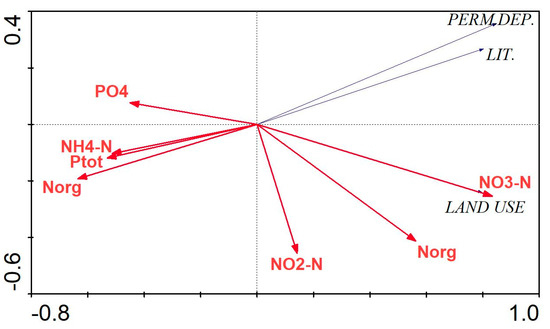
Figure 8.
An ordination diagram (biplot) based on the redundancy analysis (RDA) of groundwater quality parameters and selected soil properties and land use in catchments. The length of the arrows representing some of the soil variables emphasises their significant impact on water quality. Abbreviations: PERM.DEP.—permeability of deposits, LIT.—surface lithology, LAND USE—average depth, Ntot—total nitrogen, Norg—organic nitrogen, NO2-N—nitrite, NO3-N—nitrate, N-NH4-N—ammonium, Ptot—total phosphorus, PO4—orthophosphate.
5. Discussion
Research on the quality of ground and surface waters in catchments of three water reservoirs revealed their pollution with nutrients, both nitrogen and phosphate. Although our study was limited to only three catchments, our intention was to evaluate different aspects of agricultural activities in terms of maintaining good water quality in the artificial water bodies. The issue of water availability is even more problematic in the driest part of Poland [28,44], as well as in other parts of the world [45], creating the need for application of the most efficient methods to increase water retention. One of the most popular methods is construction of small artificial reservoirs. Most such reservoirs quickly become eutrophicated which results in their shallowing and overgrowing [46,47].
Our study shows the importance of research on groundwater quality, not only in the context of nitrate, but also phosphorus pollution. Considering the variability of the concentration values of particular elements, as well as their chemical forms, the impact of different sources of pollution from agricultural areas should be defined before implementing monitoring. For example, in the Przebędowo Reservoir catchment, nitrogen leaching from arable fields was determined, especially in the area with highest land slopes. According to the PCA analyses, piezometers in the vicinity of building development showed pollution with phosphates, suggesting pollution from sewage of nearby buildings [25,48]. In the Lake Lachotka catchment, analyses of water quality in piezometers near the farm clearly indicated animal faeces stored in open lagoons as the source of pollution. As a result of concrete corrosion, leaking of pollutants to the groundwaters supplying the lake was detected. Concentrations of nitrates measured in groundwaters of piezometers located in a straight line from the farm reached as much as 47 mg NO3− L−1. Their highest values were recorded in the direct vicinity of the farm. Similar issues have been observed in many other areas with operating animal farms [23]. Otherwise, the impact of agricultural activity on the Miedzichowo catchment was relatively weak. Discharge of wastewater from the water treatment plant had the strongest effect on the quality of running waters. No groundwater pollution caused by high fertiliser doses in arable fields was detected in the vicinity of the reservoir. The study results reveal the need for analyses of catchment land use before implementing monitoring for better planning of the location of piezometers, allowing for the identification of different sources of pollution to water bodies. Even in a small catchment such as that of Lachotka, the amount of generated nutrients was very high in comparison to that in the area studied in the Wielkopolski National Park.
The location of fields in the direct vicinity of the reservoirs, and the type of agricultural activity were of high importance, also recognised in other studies [23]. In wells in the vicinity of arable land at the Przebędowo Reservoir, the value of 50 mg NO3/L, suggested as an indicator of the negative impact of agriculture on water quality [5], was exceeded more than twice. High values of nitrates were recorded not only in groundwaters, but also in running waters periodically supplying the reservoir. Unfavourable land slopes and high filtration index values may partly contribute to faster leaching of nutrients to waters, also observed in other types of catchments [49], as well as in other parts of the Wielkopolska region [4]. Moreover, the redundancy analysis showed a significant relationship between land use and nitrate concentrations in groundwater, surface lithology, and permeability of deposits. In the direct catchment of the Przebędowo reservoir, fields are sown with maize, meaning sowing in late spring and wide spacing between rows. Low vegetation cover, particularly in early spring, may contribute to leaching of nutrients to groundwaters [24]. Lawniczak et al. [4] evidenced the negative effect of maize sowing on groundwater pollution with nitrates. On the one hand, high concentrations of nitrates were determined in waters drained from arable fields to the reservoir only periodically, in spring. On the other hand, high concentrations of nitrates, recorded only in groundwaters, were also measured throughout the growing season. Our study was conducted from March to November, but it will also be necessary to detect nutrient concentrations in groundwaters and surface waters during winter seasons. In Poland, mineral and organic fertilisation is allowed in the period from 1 March to 20 October, pursuant to European Union regulations [50]. Moreover, under our study, the greatest variation in nutrient content between months was observed in N content, strongly dependent on the type of agricultural activity in the catchment area. The highest concentration of nitrates was found in the waters of the Trojanka and Czarna Woda Rivers in March prior to the growing period, and in October after the harvest. However, groundwater quality did not show this kind of pattern due to the detection of high nitrogen concentrations also during the growing season. These results clearly indicate the importance of groundwater measurements performed throughout the year.
The study conducted in the catchment of the Lachotka Reservoir revealed the issue of improper functioning of animal farms in terms of environmental protection. Kupiec et al. [51] point to the increasing problem of the contribution of animal farms to the pollution of surface waters. Intensive farming systems, particularly high-yielding agriculture, as well as animal breeding, cause pollution of air as well as ground- and surface waters. The problem has recently become more significant due to the intensification of farm production oriented at fast profit with no consideration for the environmental aspects of their activities [51,52]. This concerns slurry landfilling, storage of liquid waste in reservoirs with variable permeability, susceptibility of slurry pits to corrosion, or their insufficient size in comparison to the amount of produced faeces, such as in the case of the farm operating near the Lachotka Reservoir. Despite the lack of compact building development in the catchment, the pig farm, and particularly open slurry lagoons, have the strongest negative effect on the lake’s water quality. The problem can even intensify due to the high corrosiveness of containers for storage of agricultural wastewater, combined with the dominant intensive animal production [53]. The issue requires monitoring and continuous farm control in terms of not only the storage, but also management of such great amounts of waste.
The quality of waters supplying the reservoirs is of key importance not only in the context of the ecological state of the reservoirs, but also in economic terms. Municipal and recreational facilities, particularly swimmers, require good water quality in aquatic ecosystems, but this is extremely difficult to achieve in artificial reservoirs due to their location on agricultural land or in highly populated areas. The problem of excessive amounts of nutrients can lead to intensive development of macrophytes [54,55], potentially restricting the exploitation of the reservoirs, or excessive phytoplankton growth, in particular cyanobacterial blooms [46]. In Lake Lachotka, it is necessary to maintain good water quality due to water intake for the purposes of fish ponds in Czaplno above the reservoir. Good water quality is necessary due to high requirements of the farmed fish species, particularly those from the family Coregonidae, such as whitefish Coregonus sp. and vendace Coregonus albula. It is particularly important because the production of stocking material of vendace is based exclusively on spawners from the lakes in the region. Another crucial aspect is the provision of the “purity” of the genetic material of the species, and their adaptation to local environmental conditions. The Ministry of Agriculture and Rural Development together with the Institute of Inland Fisheries designated the aforementioned object for the maintenance of the genetic resources of European whitefish Coregonus nilssoni and common whitefish Coregonus lavaretus (maintenance of stock of spawners and selects, production of stocking material), species whose abundance is drastically decreasing in Poland [56,57]. For this reason, farming object plays an important function in the scope of stocking material provisions in many lakes in Poland, and therefore, the preservation of a disappearing species [57].
In economic terms, the Miedzichowo and Przebędowo Reservoirs fulfil a retention and fire protection function. No fishery management is conducted there. Considering their location in agricultural catchments, particularly in the case of the Przebędowo Resevoir, the eutrophication threat is substantial. It results from a high share of arable land and occurrence of soils with a high filtration coefficient. The problem of maintenance of good water quality in dam reservoirs is serious [58,59], due to, among others, their location in agricultural areas with high water demand.
In young water bodies such as artificial reservoirs, establishing the food web takes time, and its development is very dynamic in comparison to natural lakes emerging over years. The equilibrium or stable states assemblages [18], characterised by frequent domination of several species or a certain functional group of algae, occurs in lakes in the late successional state. Most new reservoirs are small and shallow which speeds up biochemical processes in the water bodies due to their faster heating up from spring to late autumn. In comparison to natural lakes, artificial reservoirs are also young in the time scale, and more dynamic as they represent transitional ecosystems between lakes and rivers. Processes observed in this type of water bodies therefore favour intensive water eutrophication, combined with their excessive nutrient load resulting in bad water quality [24,25]. Proper catchment management and taking into account this type of reservoir is key for maintaining a proper water state. Considering a drastic increase in prices of mineral fertilisers used in agriculture, the pressure of pollution with nitrates leached from arable fields will decrease in favour of the effect of large animal farms and the related organic fertilisation of arable fields. It is therefore necessary to monitor the state of the quality of surface and groundwaters in the vicinity of large animal farms, particularly those focusing on commercial production. The surface and ground water quality are related to high production of animal faeces with intensive animal breeding, and problems with their storage and appropriate application in fields.
Our study reveals the need for analyses of the agricultural impact on the scope of standard monitoring, including analyses of direct groundwater supply to the lakes. It is particularly important in the context of artificial lakes, mostly located in areas subject to intensive agricultural production. The potential negative impact of agriculture on water reservoirs should be taken into account at the design stage of this type of dam reservoirs, including consideration of diverse methods to avoid the negative effect on water quality.
6. Conclusions
Our study showed elevated amounts of nutrients, such as nitrogen and phosphorus, frequently detected in groundwaters as well as in running waters. This confirmed our hypothesis of the importance of groundwater analysis in the identification of sources of pollution of the studied lakes. High nutrient concentrations recorded in groundwaters leached from arable fields were also observed in the summer period, which failed to confirm the hypothesis that the strongest impact of factors would be related to the spring effect of arable fields on water quality (lack of compact vegetation cover, high water level, etc.). Our study also indicated the greater importance of the type of land use than the lithology and permeability of deposits.
The location of artificial reservoirs in agricultural catchments, areas affected by agricultural land use, or in close vicinity to intensive production farms, carries a risk of increased inflow of pollutants, and therefore makes it difficult, and in extreme cases impossible, to use the waters of the reservoirs for economic purposes. This necessitates appropriate planning of the location of reservoirs with consideration to methods for their effective protection.
The effect of agriculture on water quality in reservoirs needs to be considered in standard monitoring, taking into account differences in the type of agricultural production. Restrictions regarding activities in areas strongly affected by agricultural pollution should be applied.
Supplementary Materials
The following supporting information can be downloaded at: https://www.mdpi.com/article/10.3390/w15040661/s1; Table S1: Surface lithology and ground permeability in catchments of the Lachotka, Przebędowo, and Miedzichowo Reservoirs.
Author Contributions
A.L.-M. designed the study, performed the field survey, conducted statistical analyses, and drafted the manuscript; B.N. and K.P. performed cartographical analyses, analysed and described; A.L.-M. and B.N. reviewed and edited the manuscript. All authors have read and agreed to the published version of the manuscript.
Funding
This research received no external funding.
Institutional Review Board Statement
Not applicable.
Informed Consent Statement
Not applicable.
Data Availability Statement
Not applicable.
Acknowledgments
We gratefully acknowledge Tomasz Maliński for field cooperation, and Barbara Andrzejewska for laboratory work.
Conflicts of Interest
The authors declare no conflict of interest.
References
- Sánchez Pérez, J.M.; Antiguedad, I.; Arrate, I.; García-Linares, C.; Morell, I. The influence of nitrate leaching through unsaturated soil on groundwater pollution in an agricultural area of the Basque country: A case study. Sci. Total Environ. 2003, 317, 173–187. [Google Scholar] [CrossRef]
- Galloway, J.N.; Townsend, A.R.; Erisman, J.W.; Bekunda, M.; Cai, Z.; Freney, J.R.; Martinelli, L.A.; Seitzinger, S.P.; Sutton, M.A. Transformation of the Nitrogen Cycle: Recent Trends, Questions, and Potential Solutions. Science 2008, 320, 889–892. [Google Scholar] [CrossRef]
- OECD. Eutrophication of Waters. Monitoring, Assessment and Control; OECD: Paris, France, 1982. [Google Scholar]
- Lawniczak, A.E.; Zbierska, J.; Nowak, B.; Achtenberg, K.; Grześkowiak, A.; Kanas, K. Impact of agriculture and land use on nitrate contamination in groundwater and running waters in central-west Poland. Environ. Monit. Assess. 2016, 188, 172. [Google Scholar] [CrossRef]
- European Environment Agency. ‘Nitrates’ Directive; European Environment Agency: Copenhagen, Denmark, 2000; pp. 1–8. [Google Scholar]
- do Cameira, M.R.; Rolim, J.; Valente, F.; Mesquita, M.; Dragosits, U.; Cordovil, C.M.S. Translating the agricultural N surplus hazard into groundwater pollution risk: Implications for effectiveness of mitigation measures in nitrate vulnerable zones. Agric. Ecosyst. Environ. 2021, 306, 107204. [Google Scholar] [CrossRef]
- Wei, Z.; Yu, Y.; Yi, Y. Spatial distribution of nutrient loads and thresholds in large shallow lakes: The case of Chaohu Lake, China. J. Hydrol. 2022, 613, 128466. [Google Scholar] [CrossRef]
- Tong, Y.; Huang, Z.; Janssen AB, G.; Wishart, M.; He, W.; Wang, X.; Zhao, Y. Influence of social and environmental drivers on nutrient concentrations and ratios in lakes: A comparison between China and Europe. Water Res. 2022, 227, 119347. [Google Scholar] [CrossRef]
- WIOS. Available online: www.gios.gov.pl (accessed on 1 October 2022).
- Ciecierska, H.; Dynowska, M. Podręcznik Metodyczny Biologiczne Metody Oceny Stanu Środowiska Tom 2.Ekosystemy Wodne. (Methodological Manual. Biological Methods of Assessing the State of the Environment Volume 2. Water Ecosystems); Uniwersytet Warmińsko-Mazurski w Olsztynie: Olsztyn, Poland, 2013. [Google Scholar]
- Tarabih, O.; Dang, T.D.; Paudel, R.; Arias, M.E. Lake Operation Optimization of Nutrient Exports: Application of Phosphorus Control: Application of Phosphorus Control in the Largest Subtropical Lake in the Us. SSRN Electron. J. 2022, 160, 105603. [Google Scholar] [CrossRef]
- Dunalska, J.A.; Grochowska, J.; Wiśniewski, G.; Napiórkowska-Krzebietke, A. Can we restore badly degraded urban lakes? Ecol. Eng. 2015, 82, 432–441. [Google Scholar] [CrossRef]
- Fan, X.; Gao, S.; Zhang, Y.; Qin, B.; Xu, H.; Ding, S. Stimulation of high-concentration dissolved nitrogen and reactive phosphorus in Lake Taihu sediments on the initiation and maintenance of cyanobacterial blooms. Sci. Total Environ. 2022, 851, 158088. [Google Scholar] [CrossRef]
- Zhou, J.; Han, X.; Brookes, J.D.; Qin, B. High probability of nitrogen and phosphorus co-limitation occurring in eutrophic lakes. Environ. Pollut. 2022, 292, 118276. [Google Scholar] [CrossRef]
- Follett, J.R.; Follett, R.F. Chapter 4-Relationship of Environmental Nitrogen Metabolism to Human Health, 2nd ed.; Hatfield, J.L., Follett, R.F., Eds.; Academic Press: San Diego, CA, USA, 2008; pp. 71–104. ISBN 978-0-12-374347-3. [Google Scholar]
- Zhang, L.; Zhang, W.; Cui, Z.; Hu, Y.; Schmidhalter, U.; Chen, X. Environmental, human health, and ecosystem economic performance of long-term optimizing nitrogen management for wheat production. J. Clean. Prod. 2021, 311, 127620. [Google Scholar] [CrossRef]
- Jiang, M.; Nakano, S. The crucial influence of trophic status on the relative requirement of nitrogen to phosphorus for phytoplankton growth. Water Res. 2022, 222, 118868. [Google Scholar] [CrossRef] [PubMed]
- Kozak, A.; Celewicz-Gołdyn, S.; Kuczyńska-Kippen, N. Cyanobacteria in small water bodies: The effect of habitat and catchment area conditions. Sci. Total Environ. 2019, 646, 1578–1587. [Google Scholar] [CrossRef] [PubMed]
- Recknagel, F.; Park, H.-D.; Sukenik, A.; Zohary, T. Dissolved organic nitrogen, dinoflagellates and cyanobacteria in two eutrophic lakes: Analysis by inferential modelling. Harmful Algae 2022, 114, 102229. [Google Scholar] [CrossRef]
- Pinardi, M.; Soana, E.; Severini, E.; Racchetti, E.; Celico, F.; Bartoli, M. Agricultural practices regulate the seasonality of groundwater-river nitrogen exchanges. Agric. Water Manag. 2022, 273, 107904. [Google Scholar] [CrossRef]
- Gomes, E.; Antunes, I.M.H.R.; Leitão, B. Groundwater management: Effectiveness of mitigation measures in nitrate vulnerable zones–a Portuguese case study. Groundw. Sustain. Dev. 2023, 21, 100899. [Google Scholar] [CrossRef]
- Pol, W. Północny Wschód Europy pod względem natury. In Dzieła Prozą Wincentego Pola; Nakładem, F.H., Ed.; Richtera: Lwów, Poland, 1875; pp. 1–101. [Google Scholar]
- Quemada, M.; Lassaletta, L.; Jensen, L.S.; Godinot, O.; Brentrup, F.; Buckley, C.; Foray, S.; Hvid, S.K.; Oenema, J.; Richards, K.G.; et al. Exploring nitrogen indicators of farm performance among farm types across several European case studies. Agric. Syst. 2020, 177, 102689. [Google Scholar] [CrossRef]
- Perego, A.; Basile, A.; Bonfante, A.; De Mascellis, R.; Terribile, F.; Brenna, S.; Acutis, M. Nitrate leaching under maize cropping systems in Po Valley (Italy). Agric. Ecosyst. Environ. 2012, 147, 57–65. [Google Scholar] [CrossRef]
- Jarvie, H.P.; Neal, C.; Withers, P.J.A. Sewage-effluent phosphorus: A greater risk to river eutrophication than agricultural phosphorus? Sci. Total Environ. 2006, 360, 246–253. [Google Scholar] [CrossRef]
- Qiu, H.; Gui, H.; Xu, H.; Cui, L.; Li, Z.; Yu, H. Quantifying nitrate pollution sources of shallow groundwater and related health risks based on deterministic and Monte Carlo models: A study in Huaibei mining area, Huaibei coalfield, China. Ecotoxicol. Environ. Saf. 2023, 249, 114434. [Google Scholar] [CrossRef]
- Li, W.; Wu, J.; Bai, E.; Guan, D.; Wang, A.; Yuan, F.; Wang, S.; Jin, C. Response of terrestrial nitrogen dynamics to snow cover change: A meta-analysis of experimental manipulation. Soil Biol. Biochem. 2016, 100, 51–58. [Google Scholar] [CrossRef]
- Nowak, B.; Ptak, M. Potential use of lakes as a component of small retention in Wielkopolska. E3S Web Conf. 2018, 44, 1–8. [Google Scholar] [CrossRef]
- Raport of Ministry of Infrastructure. Program Przeciwdziałania Niedoborowi Wody; Ministry of Infrastructure: Warszawa, Poland, 2021.
- Sojka, M.; Jaskuła, J.; Wicher-Dysarz, J.; Dysarz, T. Analysis of Selected Reservoirs Functioning in the Wielkopolska Region. Acta Sci. Pol. Form. Circumiectus 2017, 4, 205–215. [Google Scholar] [CrossRef]
- Sjöberg, Y.; Dessirier, B.; Ghajarnia, N.; Jaramillo, F.; Jarsjö, J.; Panahi, D.M.; Xu, D.; Zou, L.; Manzoni, S. Scaling relations reveal global and regional differences in morphometry of reservoirs and natural lakes. Sci. Total Environ. 2022, 822, 153510. [Google Scholar] [CrossRef] [PubMed]
- Dodds, W.K.; Whiles, M.R. Chapter 3-Movement of Light, Heat, and Chemicals in Water. In Aquatic Ecology, 2nd ed.; Dodds, W.K., Whiles, M.R.B., Eds.; Academic Press: London, UK, 2010; pp. 45–64. ISBN 978-0-12-374724-2. [Google Scholar]
- Elbanowska, H.; Zerbe, J. Physicochemical Analyses of Water; PWN: Poznań, Poland, 1999. (In Polish) [Google Scholar]
- Hach Company. Water Analysis Handbook, 2nd ed.; Hach Company: Loveland, CO, USA, 1992; pp. 303, 669–3050. [Google Scholar]
- Carlson, R.E. A trophic state index for lakes. Limnol. Ocean. 1977, 22, 361–369. [Google Scholar] [CrossRef]
- Forsberg, C.; Ryding, S.O. Eutrophication Parameters and Trophic State Indices in 30 Swedish Waste-Receiving Lakes. Arch. Hydrobiol. 1980, 89, 189–207. [Google Scholar]
- Ministry of Marine Economy and Inland Navigation. Rozporządzenie Ministra Gospodarki Morskiej i Żeglugi Śródlądowej z Dnia 11 Października 2019 r. w Sprawie Kryteriów i Sposobu Oceny Stanu Jednolitych Części wód Podziemnych. [Regulation of the Minister of Marine Economy and Inland Navigation) of 11 October 2019; Ministry of Marine Economy and Inland Navigation: Warsaw, Poland, 2019. [Google Scholar]
- KZGW. The Map of the Hydrographic Division of Poland at a scale of 1:10,000; Krajowy Zarząd Gospodarki Wodnej: Warsaw, Poland, 2021. [Google Scholar]
- CLC. Available online: https://clc.gios.gov.pl/index.php/clc-2018/udostepnianie (accessed on 4 September 2022).
- Main Office of Geodesy and Cartography. Available online: https://www.gov.pl/web/gugik-en (accessed on 3 September 2022).
- Pazdro, Z. Hydrogeologia Ogólna (Genral Hydrogeology); Wydawnictwa Geologiczne: Warszawa, Poland, 1990. [Google Scholar]
- Wąsik, M. Zdolność infiltracyjna utworów przypowierzchniowych a zasilanie wód podziemnych (Infiltration capacity of near-surface formations and groundwater supply). Acta Univ. Wratislav. Ser. Hydrogeol. 2003, 2591, 90. [Google Scholar]
- Ter Braak, C.J.F.; Smilauer, P. CANOCO Reference Manual and CanoDraw for Windows User’s Guide Software for Canonical Community Ordination (Version 4.5) Biometris, Wageningen; Microcomputer Power: Ithaca, NY, USA, 2002. [Google Scholar]
- Nowak, B.; Brodzińska, B.; Gezella-Nowak, I. Natural and economic factors of shrinkage of lakes of the Wielkopolska Lakeland. Limnol. Rev. 2011, 11, 123–132. [Google Scholar] [CrossRef]
- Zhang, G.; Wu, Y.; Li, H.; Zhao, W.; Wang, F.; Chen, J.; Sivakumar, B.; Liu, S.; Qiu, L.; Wang, W. Assessment of water retention variation and risk warning under climate change in an inner headwater basin in the 21st century. J. Hydrol. 2022, 615, 128717. [Google Scholar] [CrossRef]
- Lawniczak-Malińska, A.; Ptak, M.; Celewicz, S.; Choiński, A. Impact of lake morphology and shallowing on the rate of overgrowth in hard-water eutrophic lakes. Water 2018, 10, 1827. [Google Scholar] [CrossRef]
- Choiński, A.; Ptak, M.; Ławniczak, A.E. Changes in water resources of Polish lakes as influenced by natural and anthropogenic factors. Polish J. Environ. Stud. 2016, 25, 1883–1890. [Google Scholar] [CrossRef]
- Neal, C.; Jarvie, H.P.; Neal, M.; Love, A.J.; Hill, L.; Wickham, H. Water quality of treated sewage effluent in a rural area of the upper Thames Basin, southern England, and the impacts of such effluents on riverine phosphorus concentrations. J. Hydrol. 2005, 304, 103–117. [Google Scholar] [CrossRef]
- Wang, L.; Yen, H.; Huang, C.H.; Wang, Y. Erosion and covered zones altered by surface coverage effects on soil nitrogen and carbon loss from an agricultural slope under laboratory-simulated rainfall events. Int. Soil Water Conserv. Res. 2022, 10, 382–392. [Google Scholar] [CrossRef]
- IUNG-PIB Puławy. Zbiór Zaleceń Dobrej Praktyki Rolniczej Mający na Celu Ochronę wód Przed Zanieczyszczeniem Azotanami Pochodzącymi ze Źródeł Rolniczych; IUNG-PIB Puławy: Warszawa, Poland, 2019. [Google Scholar]
- Kupiec, J.M.; Staniszewski, R.; Kayzer, D. Assessment of Water Quality Indicators in the Orla River Nitrate Vulnerable Zone in the Context of New Threats in Poland. Water 2022, 14, 2287. [Google Scholar] [CrossRef]
- Kupiec, J.; Zbierska, J. Comparison of Results Obtained from Different Types of Nitrogen Balance in the Scale of a Field and a Farm. Pol. J. Environ. Stud. 2012, 21, 1295–1304. [Google Scholar]
- Ali, B.; Shah, G.A.; Traore, B.; Shah, S.A.A.; Shah, S.-S.; Al-Solaimani, S.G.M.; Hussain, Q.; Ali, N.; Shahzad, K.; Shahzad, T.; et al. Manure storage operations mitigate nutrient losses and their products can sustain soil fertility and enhance wheat productivity. J. Environ. Manag. 2019, 241, 468–478. [Google Scholar] [CrossRef]
- Lawniczak-Malińska, A.E.; Achtenberg, K. On the use of macrophytes to maintain functionality of overgrown lowland lakes. Ecol. Eng. 2018, 113, 52–60. [Google Scholar] [CrossRef]
- Lawniczak-Malińska, A.E.; Achtenberg, K. Indicator values of emergent vegetation in overgrowing lakes in relation towater and sediment chemistry. Water 2018, 10, 498. [Google Scholar] [CrossRef]
- Fopp-Bayat, D.; Kaczmarczyk, D.; Szczepkowski, M. Genetic characteristics of Polish whitefish (Coregonus lavaretus maraena) broodstocks-Recommendations for the conservation management. Czech J. Anim. Sci. 2015, 60, 171–177. [Google Scholar] [CrossRef]
- Witkowski, A.; Kotusz Jan, P.M. 65:33–52, ryb—Stan 2009. C.’my P. O. Stopien zagrozenia słodkowodnej ichtiofauny Polski: Czerwona lista minogow i ryb-stan 2009. Chronmy Przyr. Ojczysta 2009, 65, 33–52. [Google Scholar]
- Bonansea, M.; Bazán, R.; Germán, A.; Ferral, A.; Beltramone, G.; Cossavella, A.; Pinotti, L. Assessing land use and land cover change in Los Molinos reservoir watershed and the effect on the reservoir water quality. J. S. Am. Earth Sci. 2021, 108, 103243. [Google Scholar] [CrossRef]
- Eekhout, J.P.C.; Boix-Fayos, C.; Pérez-Cutillas, P.; de Vente, J. The impact of reservoir construction and changes in land use and climate on ecosystem services in a large Mediterranean catchment. J. Hydrol. 2020, 590, 125208. [Google Scholar] [CrossRef]
Disclaimer/Publisher’s Note: The statements, opinions and data contained in all publications are solely those of the individual author(s) and contributor(s) and not of MDPI and/or the editor(s). MDPI and/or the editor(s) disclaim responsibility for any injury to people or property resulting from any ideas, methods, instructions or products referred to in the content. |
© 2023 by the authors. Licensee MDPI, Basel, Switzerland. This article is an open access article distributed under the terms and conditions of the Creative Commons Attribution (CC BY) license (https://creativecommons.org/licenses/by/4.0/).